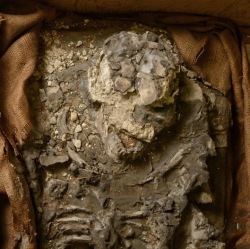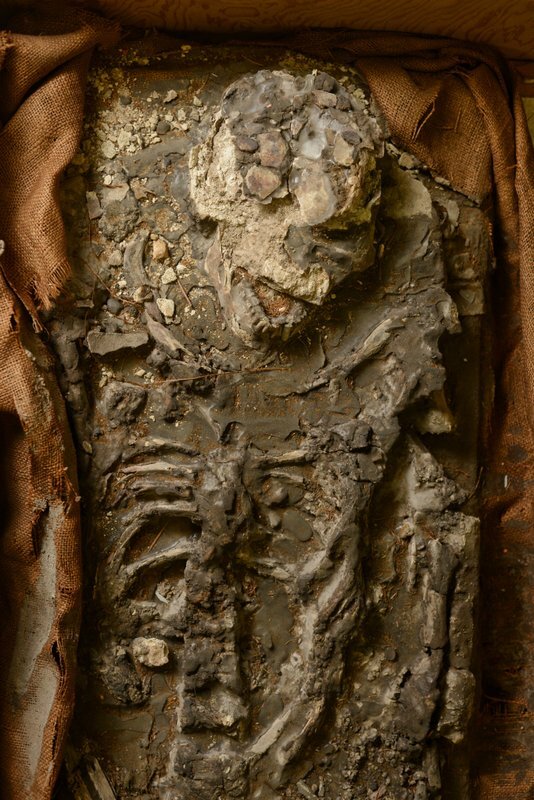
Following an early August announcement of a “rediscovered” find in a Physical Anthropology storage room—a rare, fragile, but largely intact 6,500-year-old human skeleton from the famous Ur excavations in what is now Iraq—the Penn Museum has moved the skeleton to a public space beginning Saturday, August 30.
Media throughout America, Europe, Asia, and Australia picked up on the story of the rediscovery—made possible via a digital documentation project that led to the positive identification of the ancient skeleton in a Museum storage room.
“Our goal as a museum and research institution is to share what we love with the public—the thrill of discovery, or in this case, the thrill of re-discovery,” said Julian Siggers, the Penn Museum Williams Director. “Exploring and investigating our shared human past, whether it be in the field, in the lab, in the archives, or in storage, is what makes the field of archaeology and anthropology so exciting for us. We hope our visitors can join us as we make these fascinating connections.”
Unearthed in 1929–30 by Sir Leonard Woolley’s joint Penn Museum/British Museum excavation team at the site of Ur in what is now southern Iraq, the skeleton is about 2,000 years older than the materials and remains found in the famous Mesopotamian “royal tombs,” the focus of a Penn Museum signature exhibition, Iraq’s Ancient Past: Rediscovering Ur’s Royal Cemetery.
After Woolley uncovered the Royal Cemetery, he sought the earliest levels in a deep trench that became known as “The Flood Pit” because, around 40 feet down, it reached a layer of clean, water-lain silt. Though it was apparently the end of the cultural layers, Woolley dug still further. He found burials dug into the silt and eventually another cultural layer beneath. The silt, or “flood layer,” was more than ten feet deep in places.
Reaching below sea level, Woolley determined that the original site of Ur had been a small island in a surrounding marsh. Then a great flood covered the land. People continued to live and flourish at Ur, but the disaster may have inspired legends. The first known recorded story of an epic flood comes from Sumer, now southern Iraq, and it is generally believed to be the historic precursor of the Biblical flood story written millennia later.
The burial that produced the Penn Museum skeleton along with ten pottery vessels was one of those cut into the deep silt. Therefore, the man in it had lived after the flood and was buried in its silt deposits. The Museum researchers have thus nicknamed their re-discovery “Noah,” but, as Dr. Hafford notes, “Utnapishtim might be more appropriate, for he was named in the Gilgamesh epic as the man who survived the great flood.”
According to Dr. Janet Monge, Curator-in-Charge, Physical Anthropology Section of the Penn Museum, a visual examination of the skeleton indicates it is that of a once well-muscled male, about age 50 or older. Buried fully extended with arms at his sides and hands over his abdomen, he would have stood 5’ 8” to 5’ 10” tall.
Skeletons from this time in the ancient Near East, known as the Ubaid period (roughly 5500–4000 BCE) are extremely rare; complete skeletons from this period are even rarer. Woolley’s team excavated 48 graves in the early, Ubaid-era flood plain; of those, Woolley determined that only one skeleton was in condition to recover: the skeleton that has now been identified in the Penn Museum’s collection. He coated the bones and surrounding soil in wax and shipped the entire skeleton to London, then on to Philadelphia.
____________________________
A close-up view of the upper body and skull, showing the well-preserved teeth (photo: Kyle Cassidy, 2014) Courtesy Penn Museum
___________________________
The Ur skeleton was transported from storage to the Museum’s popular, ongoing In the Artifact Lab. Part exhibition gallery, part working laboratory, In the Artifact Lab invites visitors to watch Museum conservators at work on ancient Egyptian mummies—as well as artifacts from the Egyptian Section and other collections. The Ur skeleton is on partial view while on a working table inside the glass-enclosed lab space, with some images and information provided on a video screen. As soon as conservators complete their work documenting, cleaning, and stabilizing the skeleton, it will move to a display case in front of the lab; then visitors will have an opportunity to get a very up-close view.
Conservators estimate that the skeleton will be ready to move to the case by late September (date to be posted on the Museum website when known); the skeleton will stay on view through Saturday, October 18, when the Museum celebrates International Archaeology Day with a host of family activities and a chance to visit the new Center for the Analysis of Archaeological Materials.
Opportunity to Learn More
While the skeleton is inside In the Artifact Lab and later on display, visitors will have frequent opportunities to meet with a physical anthropologist or informed physical anthropology student to ask questions. From Saturday, August 30 through Sunday, September 14 (exception: Labor Day Monday, when the Museum is open), an expert will be on hand from 11:00 am to noon, and again from 1:00 to 2:00 pm. From September 16 through International Archaeology Day on October 18, a physical anthropologist or student will be on hand Tuesday through Sunday (exception: Wednesdays) from 1:00 to 2:00 pm.
Also for those who want to find out more, Dr. William Hafford, Ur Digitization Project Manager, posted a blog entry on Beyond the Gallery Walls, the Penn Museum’s blog, with additional information about the skeleton and its history.
For more about what scientists are doing In the Artifact Lab, see the In the Artifact Lab blog and the special feature story in the current issue of Popular Archaeology Magazine.
_________________________________________
Source: Adapted and edited from two Penn Museum news releases: The Penn Museum Invites Visitors to Share in Recent “Re-Discovery”, and 6,500-Year-Old Skeleton Newly “Discovered” in the Penn Museum
_________________________________________
Travel and learn with Far Horizons.
______________________________________
Read about the most fascinating discoveries with a premium subscription to Popular Archaeology Magazine. Find out what Popular Archaeology Magazine is all about. AND MORE:
On the go? Get the smartphone version of Popular Archaeology as an app or as an ebook.
Popular Archaeology’s annual Discovery Edition eBook is a selection of the best stories published in Popular Archaeology Magazine in past issues, with an emphasis on some of the most significant, groundbreaking, or fascinating discoveries in the fields of archaeology and paleoanthropology and related fields. At least some of the articles have been updated or revised specifically for the Discovery edition. We can confidently say that there is no other single issue of an archaeology-related magazine, paper print or online, that contains as much major feature article content as this one. The latest issue, volume 2, has just been released. Go to the Discovery edition page for more information.







